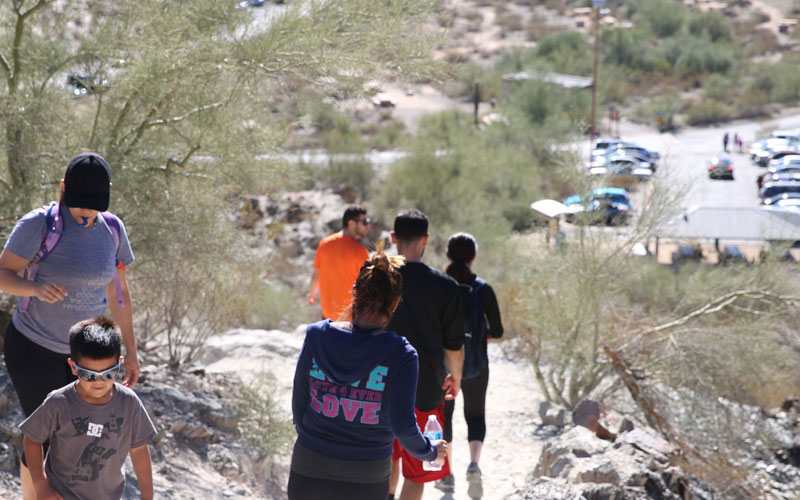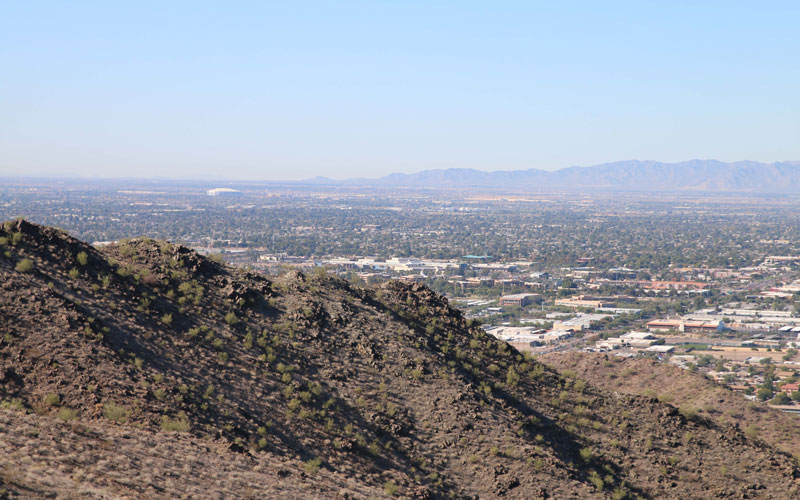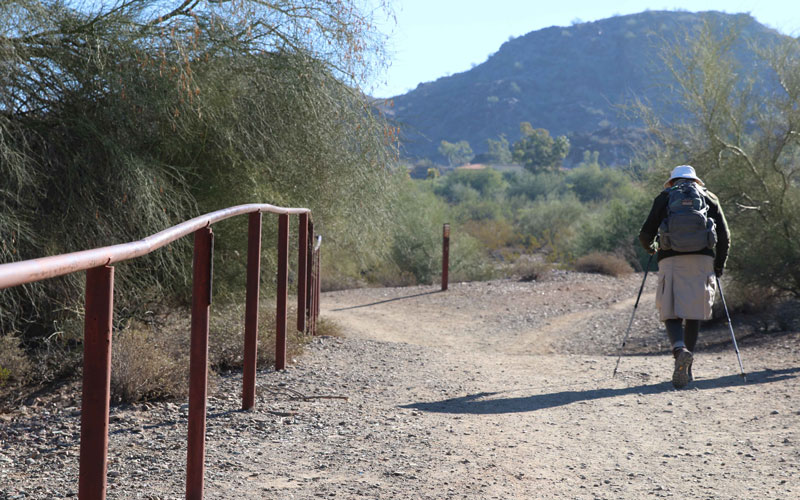
Hikers enjoy a walk up the North Mountain trail.
(Photo by Kevin Jimenez/Cronkite News)

According to Nielsen Local, Phoenix residents are 81 percent more likely than all U.S. adults to have been hiking or backpacking within the past year. (Photo by Kevin Jimenez/Cronkite News)

According to Nielsen Local, Phoenix residents are 81 percent more likely than all U.S. adults to have been hiking or backpacking within the past year. (Photo by Kevin Jimenez/Cronkite News)

Arizona Trailblazers Hiking Club President Jim Buyens has seen his club’s membership nearly double over the last year. (Photo by Kevin Jimenez/Cronkite News)
In January 2013, the city of Phoenix shut down one of its busiest hiking spots because it was too popular.
Camelback Mountain’s Echo Canyon Recreation Area had become inundated with hikers, and with it, worn-down trails and an overflowing parking situation that had brought a sea of complaints from surrounding residents.
The city spent almost a year nearly doubling the number of parking spaces at the trailhead, from 68 to 135. The first quarter-mile of the summit trail was renovated, rebuilt and rerouted to improve footing, eliminate erosion-prone areas, improve hiker safety and increase long-term sustainability for the mountain.
The shutdown and subsequent improvements to the trail shined a spotlight on the growth of hiking across the Valley.
“The Greater Phoenix area is in a trail-building boom,” said Matthew Woodson, founder and president of Okanogan Trail Construction, which led the renovations to Echo Canyon, as well as having led improvements to hundreds of miles of trails on the West Coast.
“Combine this building boom with the beauty of the Sonoran Desert, the growing number of retirees and the fantastic winter weather we have here in the Valley and you have what is becoming the premier winter hiking destination in the U.S.,” Woodson said.
Hiking has always been a part of the Arizona desert’s DNA. Nearly 50 years ago, in August 1966, the Phoenix City Council adopted a resolution that provided for “the protection and preservation of open space and wilderness within the Phoenix Mountain area.”
“I have been working in the natural resource area for almost 30 years now, primarily in trails and mountain parks, and over the last several years I have seen the amount of use on the trails continue to grow,” said Claire Miller, the north region park manager for the city of Phoenix.
Phoenix is now home to more than 40,000 acres of desert and mountain parks and preserves, and is one of the country’s best hiking cities, according to National Geographic. According to Nielsen Local, Phoenix residents are 81 percent more likely than all U.S. adults to have been hiking or backpacking within the past year.
As trails have seen more traffic, maintenance has become critical.
“The Phoenix area continues to improve its trail infrastructure and invest in its upkeep,” Woodson said. “All of the local governments have been embracing the need for more trails, as well as improving the poor condition of the old ones. By funding professional trail builders and providing volunteer training in proper maintenance techniques, the local governments have begun to embrace this need.”
Woodson said the trail improvements are key to maintaining hiking’s broad accessibility, especially for those who may be new to the activity.
“Good trails reduce the need for emergency rescues as well as providing a recreational experience that requires little training, only the ability to walk and carry water. As well, there are many new ADA (Americans with Disabilities Act) accessible trails that provide this nature experience to those with disabilities also,” Woodson said.
Arizona Trailblazers Hiking Club President Jim Buyens has seen the impact firsthand. He said that his club last year had only 40 members and now they are up to 75, the largest it has ever been.
“They do some trail maintenance, the (Scottsdale McDowell Sonoran Preserve) is always expanding, it seems,” Buyens said. “The county is building the Maricopa Trail, a 250-mile loop that goes around Phoenix. It shows that there is some commitment and that it’s worthwhile and popular.”
The city of Phoenix has wanted a way to track exactly how popular hiking is. The city is now in the process of implementing a new trail counter program to get hard data on trail usage.
“We will be able to actually document real numbers to see how many people are truly using those areas,” Miller said. “In the past it’s always been, ‘Well, the parking lot fills and you can kind of guess,’ but we really didn’t have any good quantitative method to find those numbers, which is what we are doing now.”
The city hopes to eventually install counters on all of the Valley’s trailheads.
According to Miller, Phoenix has installed 13 trail counters and is planning to install an additional 27 counters on major trailheads throughout the city.
This program will help the city not only keep track of the hikers, but also be more efficient with the management and upkeep of its trails.
“We are really excited about that. Getting those numbers will actually help us direct a lot of our management decisions, some of our maintenance protocols, and it will hopefully help with staffing,” Miller said.
Hiking in the Valley is unlike other major metropolitan areas in the U.S. because of the natural desert in which it is located. This includes the Scottsdale McDowell Sonoran Preserve, which at about 47 square miles is the largest urban preserve in the Americas, according to the city of Scottsdale.
“We are very fortunate here in the Valley of the Sun to have all of these mountain parks, spared from development by the wisdom of activists and municipal planners, so that we have pristine, remote desert right here in the middle of a huge city,” Woodson said.
Hiking is more than just exercise, and people around the Valley are taking advantage of the peace and quiet.
“For me, the ease of getting to a trailhead and accessing this desert solace here is sublime,” Woodson said. “A short hike into the preserve’s natural environment provides room to decompress from all of the hustle of city living. Hiking trails are the new therapist.”
Hiking also offers participants an activity that can be done without having to reach too much into their wallets, according to Miller.
“It’s something you can do for relatively cheap with little to no investment. If you want to spend a lot of money on it, there is plenty of gadgets and great boots, but truly all it really takes is a good pair of tennis shoes and the will to get out in the outdoors,” Miller said.